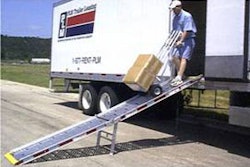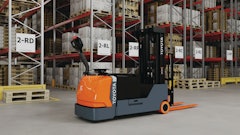What are the top challenges facing the food logistics industry? Last year, Saddle Creek Corp. set out to answer that question. The Lakeland, FL-based third-party logistics provider conducted a survey among food and beverage logistics managers to identify common practices, challenges and emerging trends that are shaping the industry.
By far, the survey found that capacity problems are the most critical. Driver shortage and increasing customer demands in the industry also topped the list. While these challenges may not be surprising, they indicate that there is a significant opportunity for companies who are able to offer solutions.
When evaluating the responses of this survey, it's clear that the food industry is disjointed, reliant upon outsourcing practices, has seasonal patterns of production and deals with highly perishable products. The industry is dependent upon a highly fragmented truck transportation system for 80 percent of its shipments (more than 600,000 interstate motor carriers in 2002 per Federal MCSA).
Meanwhile, out-of-stock products cost the food industry between $7 and $12 billion per year, according to Accenture research, with an estimated 60 percent of food and beverage items on the shelf being "slow moving" and unprofitable. Inefficient transportation and excessive inventory represent an estimated $30 billion savings opportunity to this industry.
These issues become exacerbated due to mergers and acquisitions. Disparate technology systems overlap and become cost-prohibitive. Physical distribution networks become costly to manage, integrate and re-architect.
Challenges, Emerging Trends
Currently, food companies are pressured to address these challenges while they develop a more optimized, more streamlined supply chain in order to hold minimal inventory so they're not burdened with that large investment. What are emerging trends that will help beat these challenges?
Changing business model: The industry is shaped by an Internet-driven, customer-centric marketplace. Efficient, timely order fulfillment is the new fundamental business requirement for food companies. Smaller, more frequent orders are required and fulfillment focused on value-added handling rather than warehouse storage.
Perfect orders (on-time, accurate and complete) are a food company's most important performance indicator. Neglect this metric and they risk the inevitable loss of customers and market share. Since their business is comprised of an extensive network of trading partners, this means that the quest for perfect orders must ultimately become a collaborative goal.
Increase in forward distribution centers: To enhance responsiveness and accommodate changing delivery needs, food and beverage manufacturers are establishing more forward distribution centers. This is being done, in large part, as a result of increasing changes in the truckload industry and increased demand placed upon them by their customers.
Globalization and consolidation: Retailers, manufacturers and 3PLs are consolidating in order to achieve sufficient scale to become global players. In order to compete with the largest competitors, food companies must all look to grow globally through mergers while reducing investment in hard assets and focusing their resources on those areas in which they have core competencies.
Trading partner collaboration: Leading food manufacturers and retailers are devoting resources in order to integrate information systems with their trading partners using both EDI and, more recently, web-based internet systems or e-market hubs/exchanges. Improved information sharing provides greater visibility and, with visibility, more opportunity for exception event management and supply chain monitoring.
Supply chain management: SCM addresses unplanned events, such as shipment delays, parts shortages, production delays and demand swings, which often derail optimized production and fulfillment plans. When addressed with traditional optimization applications, such initiatives give rise to rigid, linear value environments. These food supply chains must give way to dynamic supply networks and collaborative technology that drives them.
Combining logistics planning and execution: As SCM systems become better at providing the real-time data necessary to manage a supply chain, they also become better at predicting future needs and orders. Eventually, real-time execution systems are anticipated to have the capabilities that incorporate long range forecasts, plans and schedules into real-time execution systems, and will reduce the need for the advanced planning/forecasting systems used today.
Industry leaders are aligning themselves with these new SCM solutions that streamline the supply chain and optimize customer intimacy. The last decade has demonstrated that replacing inventory with information is not enough. Companies need to capitalize on inventory information by allowing their frontline operators to make decentralized, optimized decisions in real-time. The industry needs this new e-business visibility and execution solutions. A collaborative real-time supply web will give customers what they demand: faster response, better service and lower cost.
Warehousing, Transportation Trends
Cross-docking, the practice of receiving goods at one door of a facility and shipping out through the other door almost immediately without putting them in storage, is a growing trend in the industry. Nearly 43 percent of respondents have increased cross-docking practices in the past five years. For a third of respondents, the level of cross-docking has remained constant. Cross-docking shifts the focus from "supply chain" to "demand chain." For example, food stuffs coming into a cross-docking center have already been pre-allocated against a replenishment order generated by a retailer in the supply chain.
The U.S. truck transportation industry is experiencing a national shortage of truck drivers that has become a limiting factor in the operations of many food companies. In fact, more than 25 percent of respondents cite the driver shortage as being a major challenge for them. Nearly half of respondents with private fleets (48 percent) reported using company drivers for 50 to 100 percent of their shipments. Roughly another quarter (24.7 percent) use company drivers for less than 50 percent of their shipments. Nearly half (45.8 percent) of respondents use owner/operators to haul less than 25 percent of their freight.
Equipment ownership practices ran the gamut from "full-service leased equipment" (27.9 percent) to "outright owned equipment" (25 percent) to "leased equipment to purchase" (11.5 percent). Many who answered "other" used a combination of these options.
For those who do operate their own fleets, how much equipment do they have? More than half of respondents (51.5 percent) have less than 50 tractors, with 29.8 percent reporting less than five. Roughly a quarter (26.2 percent) of respondents have more than 50. More than half of respondents (55.4 percent) have less than 50 dry trailers, and, of those, 36.5 percent have less than five. Approximately one quarter of respondents (24.3 percent) have 50 or more dry trailers. Respondents owned even fewer refrigerated trailers. Nearly half (43.3 percent) own less than five, and only 23.1 percent own 50 or more.
Respondents definitely use smaller-sized shipments for their partial shipments. For 45.1 percent of respondents, outbound LTL shipments were typically less than nine tons. Another 30.8 percent shipped from 10 to 29 tons this way. The median shipment size is 15 tons. Inbound LTL shipments are even smaller. More than half of respondents (56.4 percent) report shipment sizes of less than nine tons, and about a quarter more (26 percent) have shipments of 10 to 29 tons. The median shipment size is just five tons.
A sizeable majority of respondents (58.3 percent) say that they backhaul—which is critical for minimizing costs and maximizing use of their assets, particularly with the current high diesel fuel costs. Of those respondents who backhaul, the greatest number (21.1 percent) say they achieve fewer than 10 percent. Some respondents have great success with 17.1 percent saying they achieve 81 to 100 percent of their backhauls.
Outsourcing Practices
Food shippers are interested in developing collaborative relationships with third-party logistics providers who create leaner, more efficient logistics practices within their supply chain. Nearly two-thirds of respondents (63.5 percent) outsource some or all of their transportation. Less than a third (27.9 percent) do not. Many of those who do outsource rely quite heavily on their partners.
Thirty-four percent of respondents outsource 75 to 100 percent of their transportation budget. Twenty-one percent use 25 to 75 percent of their budget. Some companies do limit their outsourcing, with 27.1 percent using less than 25 percent of their transportation budget.
Although it is not as prevalent as transportation outsourcing, more than half of companies (53.4 percent) do outsource warehousing. Nearly a third of respondents (31.7 percent) spend less than 10 percent of their budget on warehousing. However, companies spend less of their warehousing budget on outsourcing than of their transportation budget.
Thirty-four percent outsource more than 75 percent of their transportation budget, while only one-fifth of respondents (19.5 percent) outsource more than 75 percent of their warehousing budget.
Fifty-seven percent outsource part or all of their packaging. Budgets for packaging outsourcing follow along the lines of warehousing outsourcing. A significant number of respondents (44.1 percent) report using less than 10 percent of their packaging budget for outsourcing, but 18.6 percent use 75 to 100 percent.
Click here to view PDF version of Saddle Creek survey information.

















